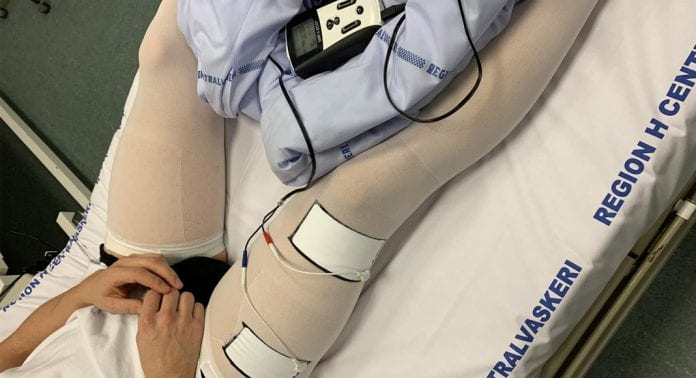
A team of researchers has developed electronic support stockings that have proven to be effective at counteracting a significant loss of muscle mass.
A team of researchers from Aarhus University has invented a biocompatible electrode for electrical muscle stimulation which has been 3D-printed onto medical support stockings. The newly developed electronic support stockings were tested on bed-ridden COVID-19 patients at Copenhagen University Hospitals. Results show that the stockings counteract a significant loss of muscle mass.
Muscle loss is a serious problem for hospitalised patients, especially patients that need intensive care and are on ventilators for long periods and recovering from muscle loss after several weeks of total inactivity may take months or years – with some patients never recovering fully.
Supporting muscles
The team tested the stockings on 16 COVID-19 patients who were hospitalised for five to seven days. They were given a support stocking on each leg, but only one of them had the printed electrodes. The leg without electrodes on the support stocking functioned as a control.
The participants’ thigh muscles were electrically stimulated with the electrodes for 30 minutes, twice a day, with an individually adapted intensity.
Charlotte Suetta, Chief Physician and professor at the University of Copenhagen and head of the clinical trials in the project, said: “The study demonstrated that these patients lost approximately 10%of their muscle mass after just five to six days of hospitalisation. However, with this new technology we’ve been able to counteract the loss.”
Current electrical stimulation of muscles poses several disadvantages – such as difficulties in getting electrodes on and off, and skin irritation in the stimulated areas.
“Our invention is much easier to use because the electrodes are an integral part of the textile,” says Shweta Agarwala, who is an expert in printed electronics, and who has been responsible for the electronics part of the setup, which was developed after breakthroughs within printed electronics technology.
The electrodes have three ultra-thin, flexible layers which can be printed directly onto different types of material, making it possible to stimulate the muscles through the stocking with minimal irritation.
“And since the electrodes are an integral part of the stockings, they can also tolerate hospitals’ cleaning processes,” continues the assistant professor.
So far, Aarhus University has printed almost 600 support stockings for medical use. The team say it is likely that the stockings can be used for a far larger group than just COVID-19 patients, including bedridden patients and for use in rehabilitation or for wheelchair users.









